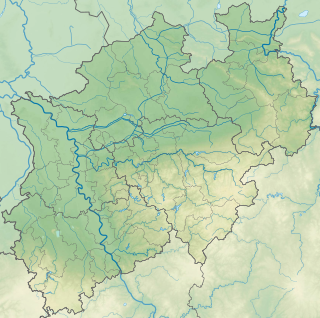Kürten plateau
| Kürten plateau | |||
|---|---|---|---|
| Systematics according to | Handbook of the natural spatial structure of Germany | ||
| Greater region 1st order | Low mountain range threshold | ||
| Greater region 2nd order | Rhenish Slate Mountains | ||
| Main unit group | 33 → Süderbergland |
||
| About main unit | 338 → Bergische plateaus |
||
| 4th order region (main unit) |
338.2 → Südbergische Plateau |
||
| 5th order region | 338.22 → Sülzbergland |
||
| Natural space |
338.220 → Kürten plateau |
||
| Geographical location | |||
| Coordinates | 51 ° 4 '20 " N , 7 ° 15' 49" E | ||
|
|||
| local community | Kürten , Wipperfürth | ||
| circle | Oberbergischer Kreis , Rheinisch-Bergischer Kreis | ||
| state | North Rhine-Westphalia | ||
| Country | Germany | ||
The Kürten plateau is a natural spatial unit with the order number 338.220 within the Südbergische plateau (order number 338.2) in the Bergisches Land , a part of the Rhenish Slate Mountains .
In the north the Kürtener plateau borders, according to the Handbook of the Natural Region Divisions of Germany in the valley of the Great Dhünn the Dhünn plateau (338.20), on the west by the Bechener plateau (338.21), on the southwest by the Paffrather Kalksenke (338.23) in the south in the valley of Kürtener Sülz to the Sülzsenken and ridge (338.225) and in the east to the Wippermulde (338.12). The northern part of Kürten and the western part of Wipperfürth are in the natural area around the district of Wipperfeld .
The Kürten plateau is an elongated plateau that gradually rises in the west from a height of 240 m to 340 to 350 m on the edge of the Wippermulde. The plateau is divided into a large northern wing and a small southern wing by the 100 m deep, wide-bottomed valley of the Kürtener Sülz, which flows on the southern edge of the natural area. Tributaries of the Great Dhünn and Kürtener Suelz divide the plateaus beyond with its many side channels , regional and Siepen called.
Over the wide northern wing which runs federal highway 506 , which runs at the height of line already in prehistoric times by an old route was used and in the Middle Ages as Heerweg served. It is also the watershed between the river systems of the Wupper and the Sieg . Geologically, it is largely determined by clay slates from the Hobräcker strata in the apex and otherwise by greywacken sandstones from the Mühlenberg strata , which coincide with the northwest flank of the Ebbe saddle . The greatest heights are distributed over both rock areas, which have different rock resistance. The construction of the saddle has a visible effect on the surface forms and the high path runs over both rock areas.
The narrow southern wing has a similar geological structure. In the south-west, the plateau extends over the slate and greywacke of the Paffrath limestone basin. The soils are dominated by medium-sized stony or sandy loams with individual loess scraps .
Individual evidence
- ↑ a b c d e Handbook of the natural spatial structure of Germany: Sheet 108/109: Düsseldorf / Erkelenz (Karlheinz Paffen, Adolf Schüttler, Heinrich Müller-Miny) 1963; 55 p. And digital version of the corresponding map (PDF; 7.4 MB)
- ↑ a b Handbook of the natural spatial structure of Germany: sheet 110: Arnsberg (Martin Bürgener) 1969; 80 p. And digital version of the associated map (PDF; 5.9 MB)
